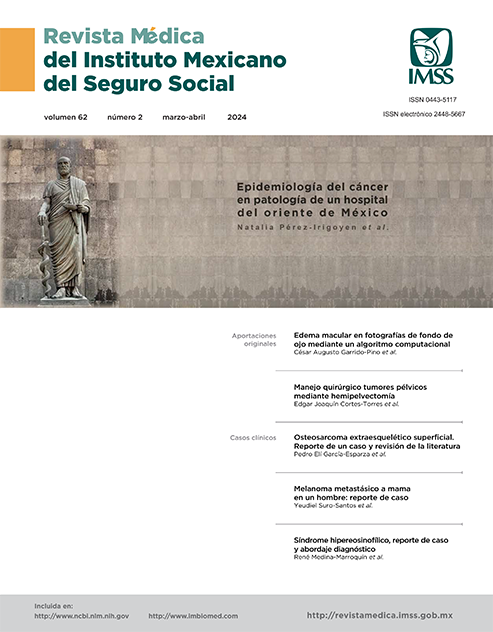Hypereosinophilic syndrome, case report and diagnostic approach
Main Article Content
Keywords
Hypereosinophilic Syndrom, Hematology, Renal Insufficiency, Chronic, Skin Manifestations
Abstract
Background: Hypereosinophilic syndrome (HES) is a rare hematological disorder, characterized by blood and tissue eosinophilia, causing tissue damage and dysfunction. The onset of the disease is generally asymptomatic, being discovered incidentally. The objective of this article is to illustrate the rare clinical presentation in patients with chronic kidney disease.
Clinical case: A 69-year-old male patient, with a history of type 2 diabetes and high blood pressure, was admitted to the internal medicine service with wasting syndrome under study, multiple urticarial skin lesions and peripheral blood cytopenias. During the approach to him, eosinophilia of more than 5.0 × 109 / L was evidenced, a bone marrow aspirate was performed, which revealed eosinophilic infiltration with dysplasia, biopsy of dermal lesions with mixed cellular infiltrate with a predominance of eosinophils; With the above, the diagnosis of idiopathic HES is made, after the exclusion of other evident eosinophilia etiologies. Systemic steroid treatment was started.
Conclusions: Eosinophilic disorders represent a heterogeneous group of rare conditions, with multiple clinical manifestations, predominantly dermatological. An important association with the development of chronic kidney disease is reported, so a comprehensive approach must be carried out, with the aim of achieving an etiological diagnosis that allows early treatment and improves survival.
References
Crane MM, Chang CM, Kobayashi MG, et al. Incidence of myeloproliferative hypereosinophilic syndrome in the United States and an estimate of all hypereosinophilic syndrome incidence. Journal of Allergy and Clinical Immunology. 2010;126(1):179-81. doi: 10.1016/j.jaci.2010.03.035.
Requena G, Van Den Bosch J, Akuthota P, et al. Clinical Profile and Treatment in Hypereosinophilic Syndrome Variants: A Pragmatic Review. The Journal of Allergy and Clinical Immunology: In Practice. 2022;10(8):2125-34. doi: 10.1016/j.jaip.2022.03.034.
Gerds AT, Gotlib J, Bose P, et al. Myeloid/Lymphoid Neoplasms with Eosinophilia and TK Fusion Genes, Version 3.2021, NCCN Clinical Practice Guidelines in Oncology. Journal of the National Comprehensive Cancer Network. 2020;18(9):1248-69. doi: 10.6004/jnccn.2020.0042.
Helbig G, Klion AD. Hypereosinophilic syndromes - An enigmatic group of disorders with an intriguing clinical spectrum and challenging treatment. Blood Reviews. 2021;49:100809. doi: 10.1016/j.blre.2021.100809.
van Balkum M, Kluin-Nelemans H, van Hellemond JJ, et al. Hypereosinophilia: a diagnostic challenge. Neth J Med. 2018;76(10):431-6.
Reiter A, Gotlib J. Myeloid neoplasms with eosinophilia. Blood. 2017;129(6):704-14. doi: 10.1182/blood-2016-10-695973.
Klion A. Hypereosinophilic syndrome: approach to treatment in the era of precision medicine. Hematology. 2018;2018(1):326-31. doi: 10.1182/asheducation-2018.1.326.
Shomali W, Gotlib J. World Health Organization‐defined eosinophilic disorders: 2022 update on diagnosis, risk stratification, and management. American J Hematol. 2022;97(1):129-48. doi: 10.1002/ajh.26352.
Shehwaro N, Langlois AL, Gueutin V, et al. Renal involvement in idiopathic hypereosinophic syndrome. Clinical Kidney Journal. 2018;6(3):272-6. doi: 10.1093/ckj/sft046.
Ogbogu PU, Bochner BS, Butterfield JH, et al. Hypereosinophilic syndrome: A multicenter, retrospective analysis of clinical characteristics and response to therapy. Journal of Allergy and Clinical Immunology. 2009;124(6):1319-1325.e3. doi: 10.1093/ckj/sft046.
Gauckler P, Shin J, Mayer G, et al. Eosinophilia and Kidney Disease: More than Just an Incidental Finding JCM. 2018;7(12):529. doi: 10.3390/jcm7120529.
Kahn JE, Groh M, Lefèvre G. A Critical Appraisal of) Classification of Hypereosinophilic Disorders. Front Med. 2017;4:216. doi: 10.3389/fmed.2017.00216.
Klion AD. Approach to the patient with suspected hypereosinophilic syndrome. Hematology. 2022;2022(1):47-54. doi: 10.1182/hematology.2022000367.
Thomsen GN, Christoffersen MN, Lindegaard HM, et al. The multidisciplinary approach to eosinophilia. Front Oncol. 2023;13:1193730. doi: 10.3389/fonc.2023.1193730.
Curras-Martin D, Patel S, Qaisar H, et al. Acute kidney injury secondary to thrombotic microangiopathy associated with idiopathic hypereosinophilic syndrome: a case report and review of the literature. J Med Case Reports. 2019;13(1):281. doi: 10.1186/s13256-019-2187-4.
Groh M, Lefèvre G, Ackermann F, et al. [Hypereosinophilic syndromes]. Rev Prat. 2019;69(7):767-73.
Kuruvilla M. Treatment of hypereosinophilic syndrome and eosinophilic dermatitis with reslizumab. Annals of Allergy, Asthma & Immunology. 2018;120(6):670-1. doi: 10.1016/j.anai.2018.02.017.
Simon D, Braathen LR, Simon HU. Anti-Interleukin-5-Therapie bei eosinophilen Erkrankungen. Hautarzt. 2019;58(2):122-7. doi: 10.1007/s00105-006-1273-x.
Fernandez-Juarez G, Perez JV, Caravaca-Fontán F, et al. Duration of Treatment with Corticosteroids and Recovery of Kidney Function in Acute Interstitial Nephritis. CJASN. 2018;13(12):1851-8. doi: 10.2215/CJN.01390118.
Podjasek JC, Butterfield JH. Mortality in hypereosinophilic syndrome: 19 years of experience at Mayo Clinic with a review of the literature. Leukemia Research. 2018;37(4):392-5. doi: 10.1016/j.leukres.2012.12.016.


